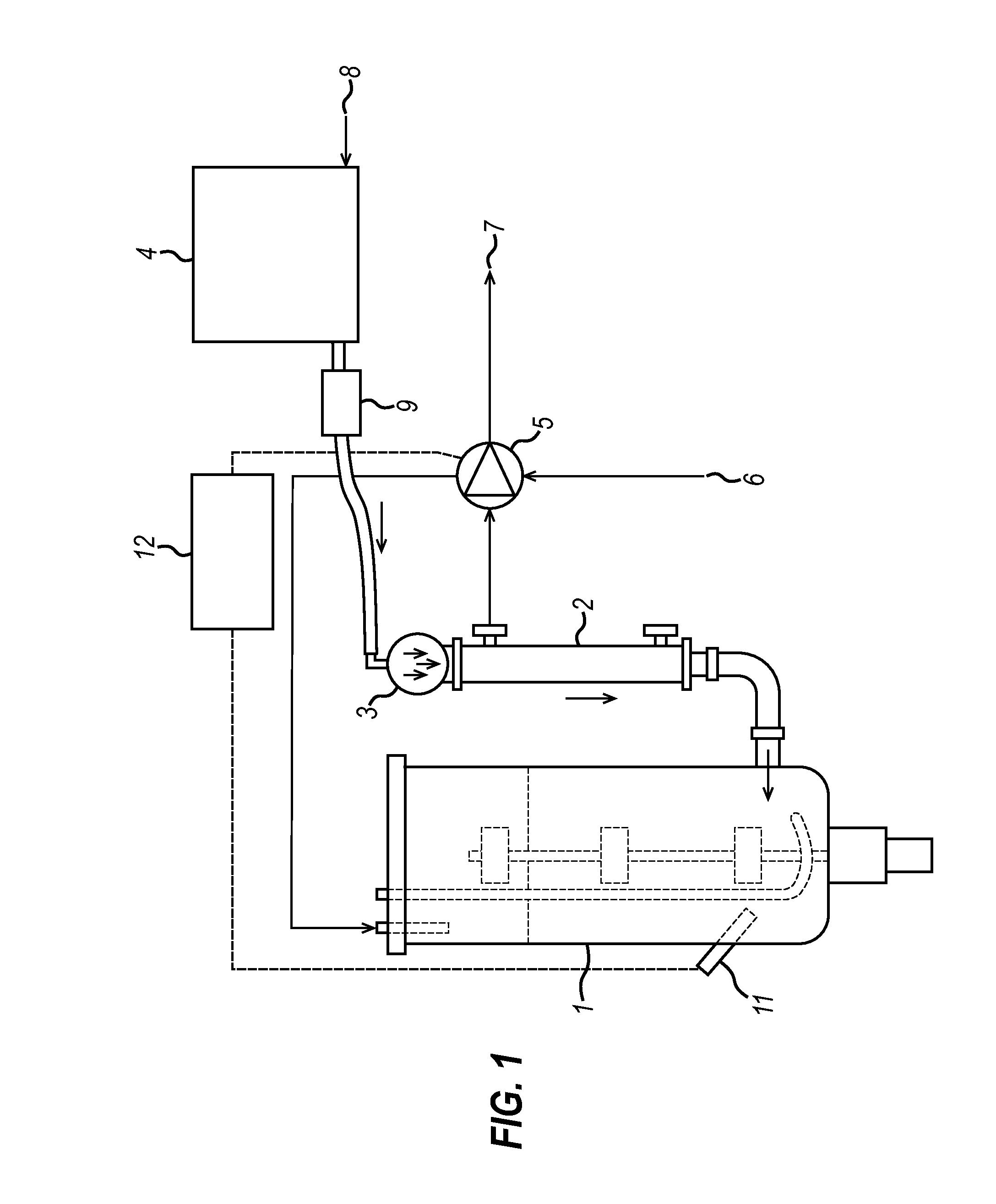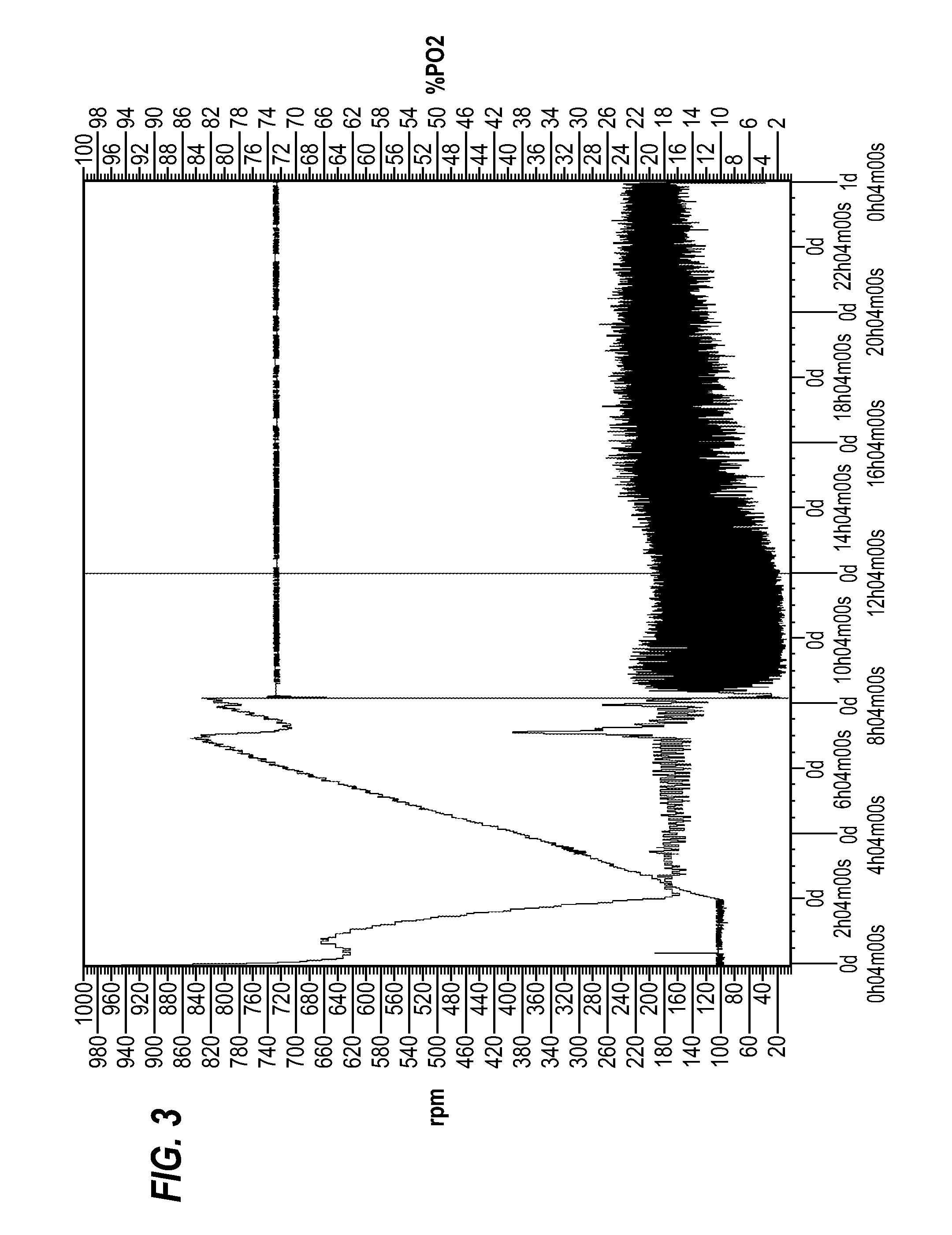Fermentation process
a fermentation process and process technology, applied in the field of fermentation, can solve the problems of viscous fermentation broth, increased pressure and volume in the fermenter, and increased pressure and volume, and achieve the effects of high yield, high yield of cellular biomass and/or biopolymer, and efficient removal of growth inhibitory metabolites
- Summary
- Abstract
- Description
- Claims
- Application Information
AI Technical Summary
Benefits of technology
Problems solved by technology
Method used
Image
Examples
example 1
[0116]Example 1 describes a process for growing Neisseria meningitidis in perfusion culture using ATF. Example 1(a) describes a process for making a solid pre-culture of N. meningitidis, Example 1(b) describes a process for making a liquid pre-culture of N. meningitidis, and Example 1(c) describes a perfusion culture using ATF initiated with a liquid pre-culture of N. meningitides as starting material.
Example 1 (a)
Neisseria meningitidis B2486 solid Pre-Culture
[0117]A solid pre-culture was prepared using a frozen seed culture of Neisseria meningitidis serotype B strain H44 / 76 (MenB). The seed culturability was determined by plating serial dilutions of the seed, as approximately 5×108 colony forming units per ml.
[0118]The seed culture was thawed to room temperature and 100 μl were used to inoculate a solid pre-culture (Agar plate) containing 15 ml of pre-culture agar medium derived from Frantz (J. Bact. 43(6): 757-761 (1942)).
[0119]The inoculated Agar plate was then incubated at 36° C...
example 1 (
Example 1(c)
20 L Scale ATF Perfused Fermentation of N, Meningitidis Using a Perfusion Rate Regulated by the Oxygen Demand
[0122]A 20-litre fermenter (Biolafitte) was used. The vessel was equipped with an Alternating Tangential Flow 4 device (ATF4 from Refine Technology). The ATF was set up with a 0.2 μm filter (GE Healthcare—CFP-2-E-8SIP) and the whole system was sterilized by autoclaving prior to being assembled to the fermenter. 13 litres of fermentation medium (a similar medium as in Example 1(b), but containing only 5 g / L glucose) were aseptically transferred into the fermenter. (If necessary, the pH of the medium may at this point be readjusted to 7.0 with base addition.) One ml of undiluted irradiated antifoam (SAG 471) was added to the fermenter. The temperature (36° C.), head pressure (0.5 bar), aeration rate (20 litres sparged air per minute) and initial agitation (stirring) speed (100 rpm) were then set prior to inoculation. The level of dissolved oxygen in these conditions...
example 2
20 L Scale ATF Perfused Fermentation of N, Meningitides Using Pre-Determined Perfusion Rates
[0132]Fermentation conditions were equivalent to those described in Example 1 except that:
[0133]1) Culture medium contained 10 g / L glucose.
[0134]2) After 3.3 h of culture (when dissolved oxygen was regulated at its set point (20%) by stirring), fermentation medium was added in a perfusion mode through the ATF device at a rate of 3.5 L / h; after 6.5 h of culture, the head pressure was decreased from 0.5 to 0.3 bar.
[0135]3) at 9.5 h of culture (when the OD650 nm reached approximately 20) when glucose became limiting for growth rate, perfusion rate was decreased from 3.5 to 2.0 L / h and maintained at this setpoint throughout the third fermentation phase (perfusion phase 2). Dissolved oxygen was also regulated by the agitation speed during the whole fermentation. At the end of fermentation (24 h), the following biomass levels were determined:
TABLE 2Final OD650 nm54 (10 L)
[0136]FIGS. 11 and 12 show ...
PUM
| Property | Measurement | Unit |
|---|---|---|
| Fraction | aaaaa | aaaaa |
| Fraction | aaaaa | aaaaa |
| Fraction | aaaaa | aaaaa |
Abstract
Description
Claims
Application Information
 Login to View More
Login to View More - R&D
- Intellectual Property
- Life Sciences
- Materials
- Tech Scout
- Unparalleled Data Quality
- Higher Quality Content
- 60% Fewer Hallucinations
Browse by: Latest US Patents, China's latest patents, Technical Efficacy Thesaurus, Application Domain, Technology Topic, Popular Technical Reports.
© 2025 PatSnap. All rights reserved.Legal|Privacy policy|Modern Slavery Act Transparency Statement|Sitemap|About US| Contact US: help@patsnap.com



